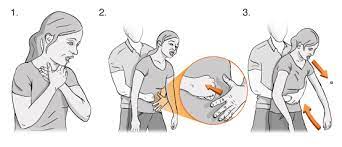- Empty cart.
- Continue Shopping
How to Administer the Heimlich Maneuver in Choking Situations

Choking can be a life-threatening emergency that can happen to anyone at any time. Whether you’re at home, in a restaurant, or at a public event, knowing how to administer the Heimlich maneuver can make the difference between life and death.
What is the Heimlich Maneuver?
The Heimlich maneuver, also known as abdominal thrusts, is a first-aid technique used to save a person who is choking on a foreign object obstructing their airway. It was developed by Dr. Henry Heimlich in 1974 and has since become a crucial skill for anyone to learn, as choking incidents can occur unexpectedly and quickly.
Recognizing Choking
Before jumping into the steps of the Heimlich maneuver, it’s essential to recognize the signs of choking. Common indicators of choking include:
- Inability to speak or difficulty in breathing.
- Clutching the throat or making the universal choking sign (hands around the throat).
- Face turning blue or purplish due to lack of oxygen.
- Violent coughing or gagging, which may worsen the situation.
Assess the Situation
When you suspect someone is choking, the first step is to assess the situation calmly and quickly. Ensure your own safety and follow these initial steps:
- Ask if the person is choking: Approach the person calmly and ask, “Are you choking?” If they can respond with a nod or a verbal affirmation, they are still able to breathe and cough, and you should encourage them to cough forcefully to try and dislodge the object.
- Call for help: If the person cannot speak, yell for someone nearby to call 911 or emergency services immediately. Time is crucial in a choking emergency, so don’t delay.
Performing the Heimlich Maneuver
If the person is unable to cough or breathe and you’ve determined that they are indeed choking, it’s time to perform the Heimlich maneuver. Follow these steps carefully:
Step 1: Stand Behind the Person
Position yourself behind the choking person and ensure they are standing or sitting upright.
Step 2: Make a Fist
Form a fist with one hand, placing the thumb side against the person’s abdomen, just above the navel and below the ribcage.
Step 3: Grasp with Other Hand
With your other hand, grasp your fist and ensure you have a firm grip.
Step 4: Deliver Abdominal Thrusts
Now, perform quick and upward abdominal thrusts using your hands and upper body. Apply enough pressure to force the object out, but be cautious not to cause harm. Perform five thrusts, aiming to dislodge the obstructing object.
Step 5: Check the Airway
After the thrusts, quickly check the person’s mouth and airway for any visible obstructions. If you see an object, use your fingers to remove it gently.
Step 6: Repeat if Necessary
If the choking persists and the person is still unable to breathe, continue with the series of five abdominal thrusts followed by checking the airway until professional help arrives or the object is expelled.
Heimlich Maneuver for Pregnant or Obese Individuals
Administering the Heimlich maneuver to pregnant or obese individuals requires slight modification to avoid causing harm. Here’s how to adapt the technique for these situations:
Pregnant Individuals:
- Position: Instead of placing your fists just above the navel, move your hand higher, closer to the chest, and perform chest thrusts.
- Pressure: Apply gentle but firm pressure to avoid harming the baby.
Obese Individuals:
- Hand Placement: When positioning your fist, ensure it is below the breastbone, closer to the base of the ribcage.
- Pressure: Use a slightly stronger force due to the added layers of fat in the abdomen.
Special Considerations for Children
When dealing with a choking child, it’s important to adapt the Heimlich maneuver to their size and age. Here’s how to administer it effectively:
- Positioning: For infants under one year old, sit down and place the baby face-down on your forearm, supporting their head and neck. Give five back blows between the shoulder blades and then turn the baby face up for chest thrusts.
- Chest Thrusts: For children over one year old, stand behind them and perform abdominal thrusts as you would for adults, but with less force.
- Monitoring: After each thrust, check the child’s mouth and remove any visible obstructions.
- Seek Help: Call 911 or emergency services immediately if the choking persists.
After the Choking Episode
Once the object is expelled, or the person can breathe again, it’s crucial to seek medical attention. Even if the person appears fine, they should be evaluated by a healthcare professional to ensure there are no lingering issues or damage caused during the choking incident.
In Conclusion, Knowing how to administer the Heimlich maneuver is a valuable skill that can save lives. Choking emergencies can happen suddenly and unexpectedly, but by following the proper steps and guidelines outlined in this guide, you can be prepared to respond effectively.
Remember to:
- Assess the situation calmly.
- Confirm if the person is choking.
- Call for professional help.
- Perform the Heimlich maneuver using the correct technique.
- Adapt the technique for pregnant, obese individuals, and children.
- Seek medical attention after the choking episode.
By being prepared and taking swift action, you can be a lifesaver in choking situations. Make it a priority to learn and practice these life-saving skills, as you never know when you might be called upon to help someone in need.








